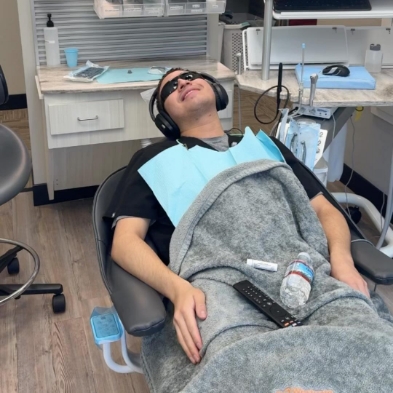Pink gum tissue
Gums and bone firmly hug and anchor the tooth
No bleeding noted during brushing, flossing, or evaluation
Unlike the phase in your childhood when your baby teeth fall out, losing teeth in your adult years is not normal. With proper hygiene practices and the modern technology of the dental field, adult teeth can and should last an entire lifetime! Unfortunately, studies indicate that about 50% of adults in the United States between the ages of 20 and 64 have lost at least one permanent tooth. The leading cause? Gum disease.
When it comes to dental health, the tooth itself is not the only part to consider. Many people forget that the gums are just important as your pearly whites. In addition to thorough preventive care, we offer effective periodontal treatment for healthy smiles. Give Westgate Dental Care a call today to schedule your appointment and learn more.
I Need a Checkup & Cleaning I am Looking for a Dentist for My Child I Have a Cavity or Broken Tooth I am Missing One or More Teeth I am Unhappy with My Smile I am Scared of the Dentist I am in Pain & Need Help I Need My Wisdom Teeth Removed I am Concerned about Sleep Apnea I Would Like to Reduce the Appearance of Fine Lines & Wrinkles View Our Services

Simply put, gum disease is an infection and inflammation of the gum tissue. Typically, it’s caused by poor dental hygiene. When plaque and bacteria build up along the gumline, an infection can occur. This is gum disease. At first, it can be treated and even reversed quite easily. However, left to its own devices, the issue will naturally worsen and begin to cause serious and permanent damage. That’s why it’s essential to identify and treat this condition as early as possible.
Gum disease progresses in stages. Depending on the severity of the infection, the treatment needed to restore your oral health will vary. Here’s a quick breakdown of the main stages of gum disease:
Pink gum tissue
Gums and bone firmly hug and anchor the tooth
No bleeding noted during brushing, flossing, or evaluation
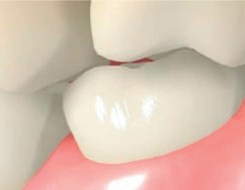
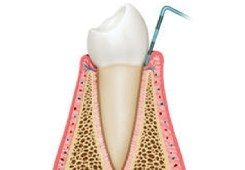
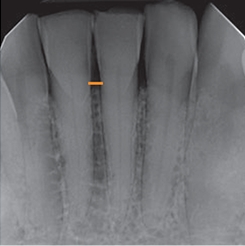
Red and inflamed gum tissue
Gums may feel tender and swollen
Possible bad breath
Bleeding gums during brushing, flossing, and/or evaluation

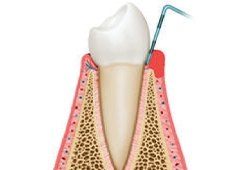
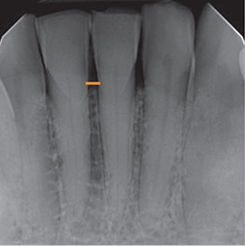
Gums separate from the teeth, creating spaces or pockets
Bad breath
Gums recede making teeth appear longer
Exposed root surfaces may be sensitive and at risk for decay
Bone loss evident on radiographs
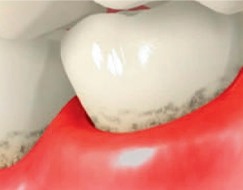
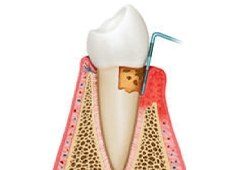
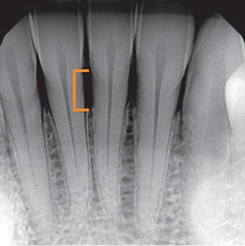
Foul odor and bad taste are constant
Teeth become mobile, and shift, changing the bite
Severe horizontal and vertical bone loss evident
Most often resulting in tooth loss
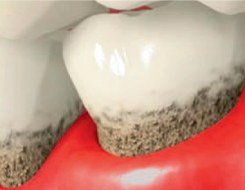
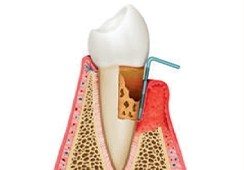
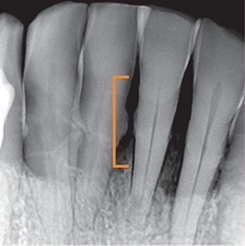
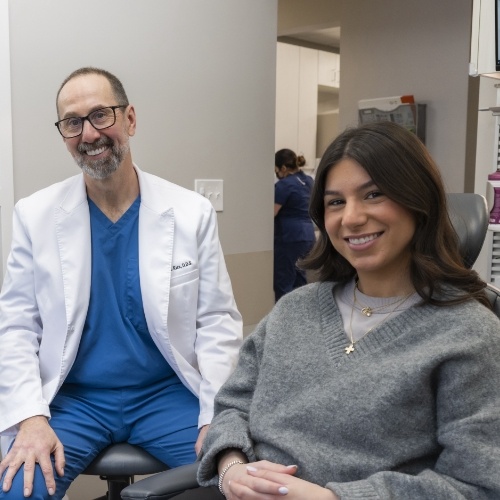
Gum disease is the leading cause of tooth loss in the United States. However, there are even bigger issues to worry about with gum disease than the health of your smile. Gum disease causes higher risks of cardiovascular disease, strokes, uncontrolled diabetes, colorectal cancer, respiratory infections, and even Alzheimer’s. As studies continue to show this relationship between gum health and overall health, it’s more vital than ever to practice a good oral healthcare routine.
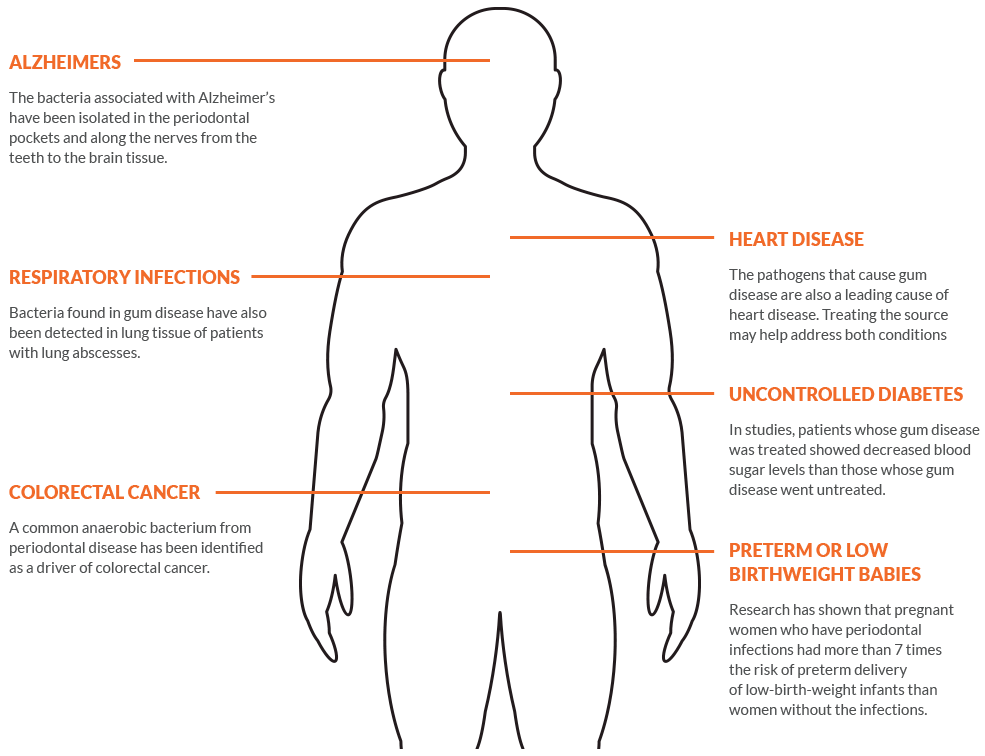

Periodontal therapy (AKA gum disease treatment) is the recommended method to help restore the area of the diseased gums. There are many forms of periodontal therapy, each designed to address a specific stage or case of gum disease. The primary goal of each treatment is to clear out the infection and restore the damaged area.

Scaling and root planing is a two-step process that we use to the earlier stages of gum disease to stop it in its tracks. In some cases, it’s known simply as a deep cleaning. First, we’ll clear all plaque and tartar from above and below the gumline to control harmful oral bacteria accumulation. This will help restore the health of your oral tissues and common symptoms like inflammation and tenderness. Then, we’ll smooth out the roots of your teeth so your gums can healthily reattach.

Our soft tissue laser utilizes a beam of light to accurately remove any severely damaged and infected gum tissue to provide your gums with a chance to heal. It cauterizes the area and at the same time removes the tissue as well, eliminating the need for sutures, scalpels, bleeding, and a long recovery time. Plus, due to the precise nature of our soft tissue laser, this treatment is fast and comfortable.
Treating Bad Breath
When battling gum disease, you may notice that you develop bad breath. Unlike the kind that forms after eating certain foods, like garlic or onions, no amount of brushing can eliminate the bacteria that cause halitosis (chronic bad breath). With the help of our Westgate Dental Care team, though, we can implement effective strategies to remove the foul odor and help you enjoy fresher breath moving forward.
Learn More About Treating Bad Breath

Thankfully, gum disease can be prevented by taking the proper steps on your own time. Be sure to brush your teeth twice a day, for two minutes each session. Angle your brush at 45 degrees on your gumline to clean away as much plaque and bacteria as possible. You should also floss your teeth once a day to remove any lingering food debris from between your teeth. Lastly, for an extra level of cleaning, use a nonalcoholic mouthwash to reach places your brush and floss cannot.
Despite your best efforts, avoiding gum disease during your lifetime may be impossible. Something as simple as not brushing or flossing as regularly as you should along with missing regular dental checkups and teeth cleanings can lead to negative consequences. If you suspect gum disease is already occurring, the best step is to schedule an appointment with a professional as soon as possible.

Gum disease is a serious oral health issue that could lead to long-term consequences for your smile! Here at Westgate Dental Care, we are committed to helping patients prevent and/or fight back against this potentially devastating condition. We are also enthusiastic about patient education, so you can feel free to ask us anything that is on your mind about gum disease or the treatments for it. In the meantime, you might gain some valuable insight by reviewing the FAQs listed below.
The sad truth is that everyone is at risk for gum disease! However, some groups are much more likely to develop it than others, including:
At first, gum disease can be very subtle. In its earliest stage, known as gingivitis, it might just cause your gums to look a little red and swollen. They might also bleed easily when you brush and floss. Persistent bad breath is also common.
As gum disease progresses into periodontitis, you might notice that your gums are receding or that your teeth start to feel loose. Increased dental sensitivity may also occur as gum recession exposes your tooth roots.
Yes, children can get gum disease. Kids who have a difficult time adapting to an oral hygiene routine, or who have disorders that affect their ability to care for their smile, are at a particularly high level of risk.
Fortunately, most cases of gum disease in kids are gingivitis, which can often be reversed via thorough oral hygiene and the support of a qualified dental team.
The bacteria that cause gum disease are trapped beneath the gumline, so they are unlikely to spread to other people through casual contact. However, to be on the safe side, you might choose to avoid sharing silverware and toothbrushes with other people while you are undergoing treatment (not sharing such items is a good practice even for people without gum disease). Also, keep in mind that kissing can allow the bacteria that cause gum disease to spread from person to person.
Basically, you should avoid any activities that involve the exchange of oral fluids.

